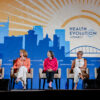Costs in the commercial health insurance market are rising at an unsustainable rate for all involved, and especially for purchasers. Research from the Kaiser Family Foundation (KFF) shows average annual premiums for a family of four were more than $25,000 in 2024—meaning “employers are shelling out the equivalent of buying an economy car for every worker every year to pay for family coverage,” KFF President and CEO Drew Altman has said.
Many industry leaders believe making commercial value-based payment (VBP) arrangements with downside risk more predictable and common offers a path forward for creating a financially sustainable payment model while delivering high-quality, whole-person care. However, VBP arrangements with two-sided risk are significantly less common in the commercial health insurance market compared to the Medicaid, Medicare Advantage, and traditional Medicare markets. And while creating a financially sustainable commercial payment model is more important than ever, due to rising health care costs and stagnant—if not declining—outcomes, information on what does and does not work in risk-based arrangements in the commercial market is not as transparently available as it is for other health insurance markets.
That’s why Health Evolution’s Roundtable on Commercial Risk-Based Contracting—a multi-stakeholder group primarily comprised of leaders from payer and provider organizations and sponsored by two technology organizations—committed to participate in the Value-Based Payment Cohort Study and identify and share key learnings that could define win-win arrangements in risk-based contracting, as well as design guidelines to build those contracts. For the study, payer and provider participants shared progress and insights on their multi-year VBP contracts with downside risk for a commercially insured population through individual interviews and virtual cohort discussions that occurred throughout fall 2021 to fall 2023.
Executives in the Roundtable compiled their findings and recommendations in a report to share with the industry. In addition, at Health Evolution’s 2024 Connect gathering, Roundtable Co-Chair Brian D. Pieninck, President & CEO, CareFirst BlueCross BlueShield, and Roundtable Fellows Christine Donohue-Henry, MD, Chief Population Health Officer, ChristianaCare, and Miles Snowden, MD, EVP of Physician Strategy, Navvis, shared some of their key takeaways and perspectives from the effort.
Absolutely Unsustainable: Leaders Must Act Now to Advance Risk-Based Commercial Payments
According to Pieninck, payers, providers, and purchasers are becoming more open to taking on risk-based payments in the commercial market. “There’s an increasing appetite in receptivity to take on more risk, and it’s not because anyone is excited or eager to be at risk. It’s because they find the solutions in the marketplace today to be unsatisfying and unsustainable for their core business models,” he said. As a result, “much of this conversation has evolved to recognize that the baseline is wholly unsustainable, and we need to get off the train,” he added.
“We absolutely know the cost of care is not sustainable,” Donohue-Henry said. Further, she continued, “we also know we’re not achieving the outcomes we need,” and having commercial payment arrangements with downside risk “really drives accountability” for providing quality care at sustainable costs.
Executives must find ways to advance VBP arrangements in the commercial market to constrain cost growth and improve care quality—and they must act now, before policymakers step in and impose regulatory structures that might be difficult for the industry, the leaders said. “Health systems and payers are responsible for driving affordability and quality to employers and to individuals. And if we don’t do it, it’s going to be done for us by the government in a way that may not make as much sense. So, this is our time to step in and to decide what makes sense in this arrangement,” Donohue-Henry urged.
Pieninck agreed. “If we don’t, I think we’re headed for a pretty significant reconciliation of this entire industry on all sides,” he said.
Still, Pieninck acknowledged “the economics has been one of the most intractable, challenging aspects of health care.” He reflected, “We all see the apparent benefits, the apparent need, and the urgency. So why has it been so hard, so confounding to see greater progress? Why is it that constructs like Medicare and Medicaid are really driving the most significant wedge into these dynamics, and why does the commercial market continue to lag and hold onto something we all agree is not sustainable?”
What are the challenges?
To answer those questions, health care executives participating in the VPB Cohort Study and Roundtable on Commercial Risk-Based Contracting “focused on the reality of what’s kept us from making this transition from volume-based payments to value-based payments” in the commercial market, Pieninck explained.
Snowden noted that the Roundtable’s report on the effort details some of the challenges that have inhibited uptake of VBP arrangements in the commercial market. In general, the Roundtable “settled on four big areas of concern or challenge in the commercial space for risk transfer,” Snowden said. “First is contract tracking. If you have only a small portion of patients being handled by a physician group or a health system who are in a particular VBP arrangement, it’s very hard for providers to know which patients are attributed to that arrangement and therefore may require certain special tasks to ensure alignment with the contact’s requirements,” he explained.
“The second is a duration mismatch,” which “is the fact that preventive expense in a current year yields a return on investment in a future year,” Snowden said. “That is totally incompatible with the annualized repricing of a fully insured population and of a budget process for a company attempting to enter a VBP arrangement on a self-funded basis,” he explained, because “the cost of pulling forward preventive expenses in hopes and in expectation of savings down the line” proves difficult in a market “where someone might be churning through different employers or payers.”
“The third challenge is risk or acuity of the population being managed,” Snowden said. He explained, “You typically have a very low-acuity population on the commercial side relative to Medicaid and Medicare,” but “you’ll want to employ many of the same tactics, use the same technology, and have a lot of the same fixed expenses for population health for a commercial risk-based contract that you would for Medicare Advantage or Medicaid” for efficiency. “So how do you find a way to allow for those tactics to be accomplished in a low-risk population?” he remarked.
“And the last challenge is quality metric diffusion across different payers,” Snowden said. “There’s too much diffusion of quality metrics across different types of payers, and the inability to consolidate quality metrics into a common agreed set across Medicare, most state Medicaid programs, and most commercial offerings is a super big challenge that has to be addressed.”
In addition, Snowden noted that employer and purchaser market dynamics can make it difficult to broadly scale VBP arrangements. For example, he said, “There’s a diverse distribution of risk in a given community across self-funded employers and commercial fully insured. As a result, it becomes very difficult for any one of those stakeholders, the payer or the employer, to have the leverage needed to create change.”
What are the solutions?
To work through the challenges, executives participating in the VPB Cohort Study shared their experiences with creating and implementing VBP contracts, focusing on how “to work out problems of coming together on commercial-risk agreements and how to scale,” Donohue-Henry said.
For example, as part of the study, Donohue-Henry shared details of ChristianaCare’s 10-year collaboration with Highmark Health, including how the organizations have worked together to create and expand VBP arrangements—and overcome obstacles that have emerged along the way. “The goal of the collaboration is to work together to essentially solve the problems in health care, or the so-called ‘quadruple aim’: the cost, the quality, our patient’s experience, and our clinicians’ experience,” Donohue-Henry said.
Throughout their collaboration, senior leaders at ChristianaCare and Highmark Health have recognized “it’s hard work and, culturally, there’s a big difference between a payer and provider. There’s a lot of history there, and it’s challenging to overcome that,” Donohue-Henry shared. But focusing on shared goals and opportunities has helped the organizations “learn a lot” and “work through a lot of challenges as it relates to delivering a clinical model to patients in a payer environment,” she noted.
Primarily, Donohue-Henry said, the organizations have learned it’s “absolutely imperative to work out the kinks and understand the culture” of a partnership in order to overcome the obstacles of advancing commercial risk-based payment arrangements.
Pieninck noted the report from Health Evolution’s Roundtable on Commercial Risk-Based Contracting details “what’s worked, what hasn’t worked, and how different types of organizations can collaborate and occupy space together,” as well as “the early tenants that are required to really allow for momentum to be sustained” in advancing commercial risk-based payment arrangements. The report outlines how organizations can “come together and find something to work on that’s a shared opportunity, and then over time mature into downside risk for commercial applications,” he said.
The Roundtable’s paramount recommendation, Pieninck said, is that “to really make this effective, industry participants must be willing to set down things that are individually important to them for the greater good of a relationship or consistency in a community from a quality and cost perspective.” Pieninck contended, “It’s not just the practices, it’s not just the payment structures, it’s also our mindset and the cultures that we bring into these things. We need to look at the circumstances that exist within the context of where health care is supplied and consumed, as well as the unique capabilities of the parties that are involved in setting up this relationship. Then, we need to highlight the best of what each of us do, set down the things we’ve not been doing well, and produce something of greater value.”
Learn more about the Roundtable’s findings and recommendations in Health Evolution’s latest report, Designing Win-Win Commercial Risk-Based Contracts. Access the report here:










